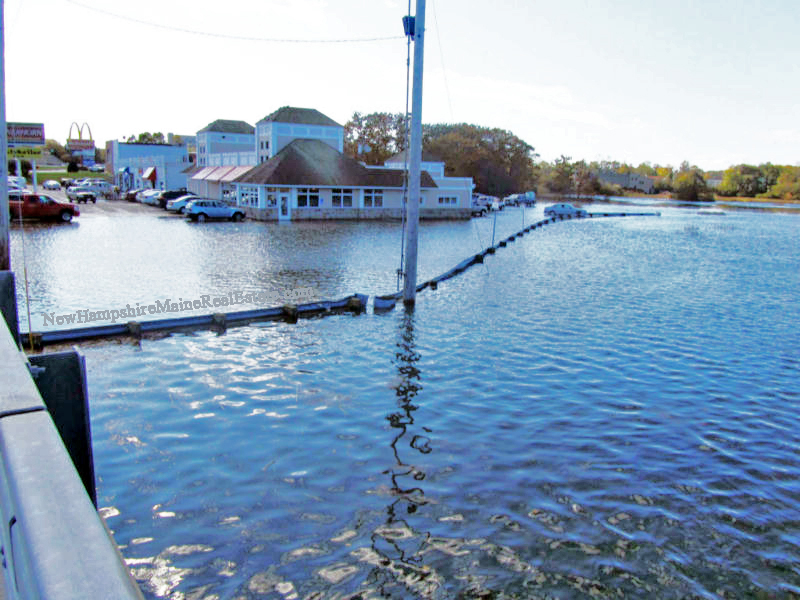Take a deep breath. Join us as we dig deeper to explore in this four-part
series the underlying causes for coastal flooding in the Piscataqua River
Basin.
This is a four-part series. Part I shows that sea level rise, especially in Portsmouth, is not a significant threat to Portsmouth residents. Don’t sell that shoreside mansion just because the sea level is rising!! It’s just not that big a deal!
In Part II we look at whether sea level rising is a problem elsewhere in the region. After all, the North Atlantic Ocean should behave the same, whether you are in Portsmouth or New York City.
Good news! It does!! Well, that’s a relief. Sea level rise is under a foot over the past 100 years, whether you are in Maine, New Hampshire or New York City.
There are variations to this conclusion and we discuss them. But the conclusion remains.
What causes sea level to rise? And why, as we will see, does it vary over time? We discuss this, too. The reasons why sea level rises and why it varies are not what you think. So hold on to your hats! We have some fun discussion ahead!
From Local to Regional
We focused on the local picture in Part I by looking at just the tidal stations at Seavey Island and Fort Point in Portsmouth Harbor. Both of these stations give us a picture of what sea level is doing in the lower part of the Piscataqua River.
Portsmouth Harbor sea level has risen by less than a foot in the past 100 years!
That’s 2 millimeters a year.
What’s a millimeter? The thickness of your driver’s license is 1 millimeter. There are 254 millimeters in one inch. The thickness of a pencil lead is about a half a millimeter (0.5 mm). So, a millimeter is pretty small.
What about the regional picture? By looking at other tidal stations in New England, we can put these numbers in context. We can see if Portsmouth’s numbers are very different from other coastal tidal stations in New England. In this way, we can also gain a better understanding of the dynamics of sea level movement.
How do these readings compare with regional readings up and down the East Coast?
The graph below, titled “Relative Sea Level Trends for North Atlantic” from the National Oceanic and Atmospheric Administration (NOAA) shows the range of sea level rise from Eastport, Maine to the Battery at the tip of Manhattan.
Two observations:
First: Why are some bars “longer” than others? Cutler, Maine, Nantucket and Bridgeport, Connecticut all show more “scatter”, generating longer bars.
If a station has been recording for only 30 to 40 years, the vertical bar tends to be longer, meaning that the range of reports is greater. The “scatter” of results is greater. The measurements haven’t yet “clustered” around a central point. More data over a greater time period can help make the bars shorter if the data become tighter.
Second: Shouldn’t all these rates of sea level rise be the same? It’s the same North Atlantic Ocean!
NOAA states that the regional absolute global sea level rise is “believed to be 1.7 plus or minus 0.3 millimeters/ year during the 20th century.” That’s anywhere from 1.4 millimeters/year to 2.0 millimeters/year.

The amount of sea level rise from Cape Cod to Eastport is all under 3 millimeters/year…
The numbers from New Hampshire and Portland, Maine are much lower than 3 millimeters at 1.9 mm/year (Portland) and 2.04 mm/year (Fort Point).
…but from Cape Cod to New York City, the numbers trend a little higher.
The difference between the northern tidal stations and the southern ones has to do with what the land, not the sea, is doing. It is not stationary in a vertical sense. Its vertical movement is called isostasy.
The differences in these numbers from Maine to Manhattan is believed to be due to how much the land, in these cases, is sinking.
Look at Nantucket, which shows a regional high level of 3.85 millimeters/year. That is because the Nantucket station is sinking at a faster rate than Portland, Maine…
How much is Nantucket sinking each year? We can calculate this. It is the observed value from the above graph, 3.85 mm/year less the 1.7 mm/year that the North Atlantic Ocean rises on average each year. That gives us 2.15 mm/year for the rate at which Nantucket sinks each year.
…the same calculation shows that Fort Point here in Portsmouth would appear to be sinking at “only” 0.3 mm/year.
How about our beloved Prescott Park? Because of the poor-quality fill (remember it used to be a garbage dump), compressible stream deposits and the marine clay under Prescott Part, we believe that the Park is sinking at a faster rate that either Seavey Island or Fort Point.
No wonder it is flooding!
Let’s dig into these data a little more. There’s much to be discovered!
The Rate of Sea Level Rising Varies over Time!
You’d think that if carbon dioxide (CO2) concentrations in the atmosphere are increasing and that they are blamed for causing sea level to rise, then all of these NOAA graphs from Seavey Island, Fort Point and the Battery would show the rates of rising sea level to be increasing and accelerating! But in fact these graphs (and others) show the rate of sea level rising to be tapering off. From Part I, we saw that the time series of sea level changes at Fort Point and Seavey Island suggests that rates sea level rising have slowed over the past 50 years.
Let’s look at the Battery records which extend further back in history to the mid-1800s and have the advantage of not being located on a constricted river.

At the Battery, the long-term rate of sea level rise is a little higher than Portsmouth or Portland, Maine. But not by much. The difference is maybe 3 inches or a quarter of a foot over a century.
Looking carefully at the plots, the slope of sea level rise over the past twenty years seems to be flattening slightly, meaning that the rate of sea level rise is slowing slightly to a rate that may be less than the long-term average rate of 2.89 mm/year for the past century.
We saw a similar slowing of the rate of sea level rise with the two Portsmouth stations.
The graph shows there are other periods at the Battery when this has happened, such as the period from 1895 to 1915.
Even as we look at the broader picture from Maine to Manhattan, we come away with much of the same conclusion. Sea level is rising, but it appears to be slowing over the past 20 years.
We have seen that the overall rate of sea level rise is manageable and not catastrophic. In Part III, we will want to know what causes sea level to rise. Apparently, it is not all due to carbon dioxide in the atmosphere. We also want to know what causes the rate of rise to vary over decades. Next, we will look at possible reasons why the rate of sea level rising varies. Hint: it’s not what you might think!
Editor's Note: This article was originally published with the title "Expected Sea Level Rise Will Put Us All Under Water! (Not!) Part II"










